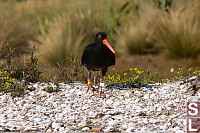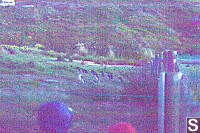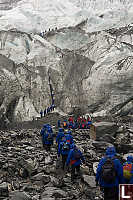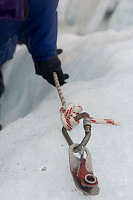
New Zealand

 Nice place to go for a wedding
Nice place to go for a wedding
New Zealand is part 2 of my 2 month
sabbatical -
before New Zealand, I was in
Hong Kong
and after New Zealand I flew to
India. New Zealand isn't close to anything except perhaps
Australia and not coming from Australia (except Gabi) we all had long
flights. We had three weeks booked for our vacation so we decided
to break it into roughly three pieces - North Island, The Wedding and
South Island. I worked the wedding so I don't have any photos -
if you really want some, talk to the usual suspects.
Rotorua and Area
My long flight ended with a beautiful sunrise
over the
ocean and a morning landing in Auckland. We rented a car, drove
three hours and found our first location - a farm rental in Rotorua.
We booked a number of nights here (six I think) and the plan was to use
this as a base and fan out from here to see some of the North Island
sights. The vacation rental turned out to be a destination unto
its own. It's a large working farm with rolling hills dotted in
sheep and lovely walks.


I was quite surprised to find sheep don't exactly love humans. In
fact, for the most part they run away. Over the week I found out
more about how mean humans are - I understood sheering sucked for the
sheep (I'm cold!), but they also cut off the sheep's tails to keep
things clean. Poor sheep!
Our first destination was Wai-O-Tapu Thermal Wonderland. It was
only a few minutes down the road from our house so we felt quite bad
when we realized our late arrival meant we missed the daily big show -
the Lady Knox geyser going off at 10am. Oh well.

The
park has a number of "craters" where various coloured fluids boil
and steam. I'm a big fan of hot springs but these are all
way too hot for bathing - most would kill you in seconds. The mud
pits were apparently almost 100 °C.
The star attraction of this site is the
Champagne Pool. This
large very steamy pool has a vibrant orange ring apparently from
antimony dissolved out of the rocks lower down.
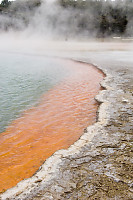

The
pool feeds a large plane of deposits where the minerals slowly
precipitate out as the water cools.
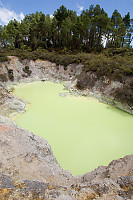
Sulfur
dominates this area. One highlight for me was finding
a small vent covered in sulfur crystals.

A few days later we made it back to see the
Lady Knox
"erupt". Apparently this geyser would erupt on it's own every 2
or 3 days but the site staff soap the geyser into erupting every day
just before 10am. The eruption, once started, goes for about 45
minuets. We spent quite a while trying to figure out how
adding a surfactant could cause the superheated water in the bottom of
the geyser to start mixing with the cooler water above it and then
explosively change to steam when it got near the surface. We have
a theory.
Caves in Waitomo
Waitomo is one of those one attraction towns -
you go for the
caves. There are at least 5 big tour companies and a lot of
smaller related tourist functions. I had found some tours on the
internet and I had some
ideas for tours. We got up early and drove the 2 hours across the
island to get there at a reasonable time. Turns out the
iSite (tourist office - found pretty much everywhere in New Zealand)
had a really good system for booking with any of
the tour operators and listed every available tour and the pros and
cons of each. Turns out we were too late for the morning tours so
we picked a combo afternoon tour and had lunch.
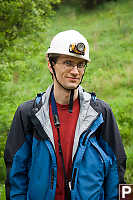
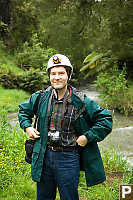
A 15 minute drive into the farmers fields and we got out for a short
walk. Basically, all of these caves are on private land (farms)
and the farmer makes a private deal with the tour company for
access. You won't generally see another group in your cave.
Our first cave was a wet cave - the river just disappears into
it. It was quite surprising to see this big river (which had cut
the valley) just disappear like that - we don't have so many of these
formations in my part of the world.
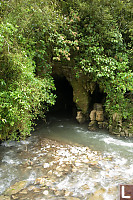
It didn't take very long into the cave before
we could
see the glow worms on the roof. Apparently they glow to make a
"starry night" for larvae emerging out of the water. The new born
bugs fly up to the stars to get away from the trees and it turns out
the stars are actually threads (like a spiders web) that trap the
insects. The glow worms haul up the catch, eat, and then
(eventually) become a moth and go out and mate.
Our second cave was a drier cave. This
cave had more of the
traditional stalactites/stalagmites that people associate with
caving. Being so dry there was very little glow worm activity to
be seen.

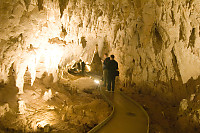
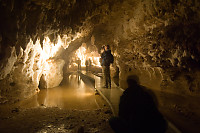
The nice thing about this cave was the concrete path and the patience
of the guide (and other guests) to me taking photos. Many of the
tours in this area are "extreme" and generally discourage or ban
cameras.
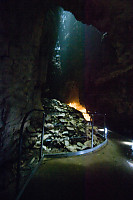
A
few things different from Canada - this cave had "
skylights"
where the roof had caved in. Our caves generally go down and into
the sides of mountains - the only light you see is another
entrance. The second feature was a Moa skeleton on the cave
floor. I've seen bones in caves before, but not from an extinct
species! There was a small pile of "gall stones" that obviously
didn't fit the cave type rocks. I was impressed.
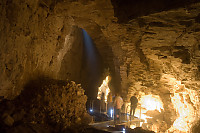

Tarawera Falls

Truth is, we got a lot of rain. We are
from the
west coast of Canada so a lot of rain really isn't a novel thing, but
it can put a damper on activity. We had originally intended to do
the Tongariro Crossing but the steady rain combined with reports of
significant snow on the root effectively killed that idea.
Instead
we looked up the guide book and found a small local attraction called
Tarawera falls.
Getting there involved a long drive (perhaps an hour) and then a short
walk. Most of North Island New Zealand has been cut down to make
pasture land for farms. When we drove we crossed through a few
parks with thick original (old) growth. It was amazing to me to
see how dense the plant life grew.
The hike itself was quite good. It was pouring rain but the local
stone is quite porous and we had no problem with slippery
footings. The falls themselves are quite neat (they would be a
big
attraction in Vancouver) - the water comes out of caves in the
rock. We walked up and behind to where the water enters the caves
and seeing a river disappear into a rock face is quite a scary thing to
see.
White Island
I'm pretty sure that this company was rated the
best tourist attraction
in New Zealand recently. I understand why. We called to
book a spot (or 3) on the boat and were told the bad weather made it
day to day. They said they would call back on the morning they
sailed and give us enough warning to drive the 1.5 hours to get
there. They kept their word - it would be a difficult crossing,
but they were sailing.
The sailing across was "rough". The boat comes with bags and the
staff walked around with moist hand towels for anyone who used the
bags. I felt pretty terrible by the time we arrived (the crossing
took something like an hour even though the boat hauls). Once I
saw where were going, I got over my upset tummy. We were issued
our gas masks and we got on the zodiak to come over.
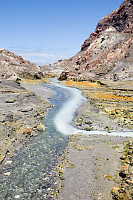
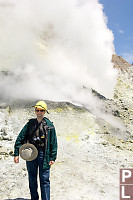
This place is pretty much as close to moon scape you can get at this
elevation. The whole place has yellow stains from the sulfur
coming from the ground and there are steam vents all over. You
actually need your gas mask - sometimes the smell and taste of sulfur
in the air is strong enough that you want to breath better air.
We stayed together as a group and walked on the established paths - you
could see where missteps lead to "warm" experiences.
At the high end of the crater is a large, very ugly lake.
Apparently the lake is off the scale for acidity. There sulfur
(as in sulfuric acid) floating on the surface. The water was
apparently about 70°C. You would be seriously toast in this
lake. Apparently this used to be a huge, very steamy vent but a
coincidental flooding of condensed liquid effectively quenched the vent
and the pressure changed the emission to be liquid rather than gas so
the lake formed.
The guides tried to answer our questions and told us stories about the
mining efforts that took place here over the years.

We got back to our starting point (a
destroyed factory) and then queued up to get back to the boat. I
could see nesting colonies high on the ridges and you can even spot the
odd bit of green trying to colonize. One of my favorite visits in
New Zealand.

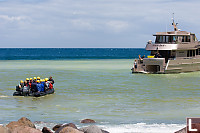
Rotorura was a great base of operations but we had to get on with our
trip. Our next location was Waheke Island near Auckland. We
drove back to Auckland, picked up Helen and went to the ferry.
3pm or so and we are standing on the Southern Hemisphere equivalent of
Salt Spring.
Waiheke Island
Our rental house on Waiheke was about a 20 minute drive from the ferry
terminal and on
the less occupied end of the island. The location meant no near
neighbors and a pristine view as well as several local attractions.
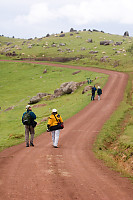
As far as I can tell, there are three big
attractions on Waiheke
Island. Beaches, Stony
Batter, and the Wineries and related cottage industries. We
thought we would try Stony Batter first.

The light in New Zealand not like Vancouver. Yes things are super
green (they get a good amount of rain) but something about the
latitude or lack of ozone layer gives saturated light. The
geography (pretty flat here) meant the clouds were often
interesting. For us, just watching the light was cool.

Waiheke is known for it's wine. There
are
vineyards of various sizes
all over the island and while November isn't prime season and midweek
isn't the best time to visit, we found a number of wineries open and
sampling. We chose one for lunch and had a good time on their
patio.
After the wedding we looked for a good activity and the local beach (
Whakanewha Regional Park) turned out to be an
ideal destination. The long flat beach is good for walking and
the water was warm enough that a swim wouldn't kill you.
The next day our large party broke up and went
to the various parts of
New Zealand. Five of us stuck together and boarded a plane for
the South Island.
South Island
We only had 6 days for the South Island and we found (much like
BC) the South Island has more space between attractions. We
decided to land in one city and leave from another and to concentrated
on wildlife and outdoors stuff (things I like to do in Canada) rather
than some of the more extreme things available in New Zealand (like Jet
Boating).
Taiaroa Head
We flew into Dunedin, rented the car, went to
the hotel and almost
immediately turned around and drove out to Taiaroa head on the end of
the Otago Peninsula to see the Northern Royal Albatross colony.
This is a me thing - I'm not a birder I swear!
You are guaranteed to see an albatross or they will give you your money
back. You aren't guaranteed to see them do anything. It was
a windy day (the flight in was fun) so there were a number of birds in
the air just flying around or practicing landing. These large
birds nest here but not every bird here is nesting - some are juveniles
that
didn't get around to it this year, others may have lost an egg
(although this year apparently is good - all are still viable).
After an orientation you get half an hour in the viewing room - a well
finished house with tinted windows that don't open. The guide
will tell you anything you want to know about the birds. It
wasn't long, but it sure was a good time. After we got out,
we explored the rest of the head.
I actually quite enjoyed the sea gulls in the parking lot. Like
most sea gulls, they completely ignored us to go about annoying each
other. Because it's easy to get close, it's much easier to get
good action shots.
Further from the parking lot there are large cliffs covered in nesting
shags. We have similar species in Canada (Cormorants) but we
don't have colonies like this so close to town. In the falling
light, they were fun to watch.


I've never seen penguins in the wild and there are two species common
here - yellow eyes and the little blue penguins. The blue
penguins come in at sunset and we got a variety of answers of when
that was - as early as 8:45 or as late as 9:15. We didn't really
have anywhere to go so we figured we would wait for it.
10pm is not a good time to go looking for dinner in this part of the
world. We found a subway in downtown Dunedin and were happy for
it. The next morning we had breakfast at a real restaurant and
were happier still. Today was a short driving day - our beds were
about 200km north of here. We poked around Dunedin a bit and then
drove north.

Shag Point
Ironic - no shags. The beautiful
beach was
a great stop to eat our sandwiches and go for a short walk.
You can't get very close but down on the rocks you can sometimes see
fur seals that have hauled themselves out on the rocks. In one
case we saw a basking seal bothered by a seal swimming by. With
all the rock space available, you really have to wonder why they can't
just get along.
Moeraki Boulders

Further up the coast we visited Moeraki
Boulders - a
bunch of rocks on the beach. What impressed me most was how many
people stopped to visit. This section of the coast line is pretty
sparse so I think this beach stop is popular as much for walk as the
dinosaur egg like rocks on the beach.
We found one rock that was "split open" so we
could get hatching photos.
Farmstay
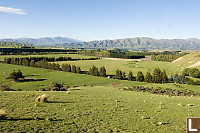
We've had a few cases of "we need a place to
stay
between A and B - pick something". In Japan,
Matsumoto is an example of intermediate
location surprise. On this trip, a farm stay near Kurow was our
example of
intermediate location surprise. We arrived in the later afternoon
and took
a little stroll to get the blood flowing before we went in for dinner.

Unlike our first farmstay with was basically and overgrown hobby farm
(with excellent conditions including for the tourists),
this is hard working farm on marginal land. The boundaries
of the property are
marked by mountain ridges and deep cut streams. We followed the
sheep as they moved up to high ground for the night. We stumbled
across a nearly new born (probably less than two week old) lamb and he
(with some confusion) agreed to submit to having his photo taken.
We had an excellent dinner (skewers on the BBQ) and spoke with the
locals about the realities of farming in New Zealand. We slept
well.
Our next day was our big driving day. We had about 500km to cover
and it
would take most of the day. We got a good farm breakfast
and then on our way. We didn't make it very far before our first
stop - a large power dam just up the road.


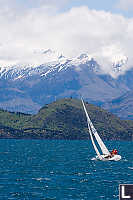

We stopped in Wanaka for lunch. This place reminded
me a lot of Banff - it's ringed by beautiful mountains and the city
exists pretty much exclusively for tourists. We stopped by a
local
winery which was about as idyllic as they come. The winery was
unpretentious (especailly compared to Waiheke) and really about wine
which
was quite nice. There is a lot of pinot noir grown in this region
(
unlike our back yard)
and it's quite tasty.
At the end of a lot of driving we arrived in the town of Franz Josef
Glacier. We were pretty wiped by the long drive (beautiful
country) so we found our hotel and crashed. The next morning we
decided to take an "off day" and took advantage of a nice day for a
walk on a very windy beach.
I was pulling sand out of my ears for days after that
walk. We were on the west coast of the Island and the next
thing west after this coast is South America - most of the way around
the planet.
Franz Josef Glacier
If White Island is the star attraction of the
North Island, then Franz
Josef Glacier is the star attraction of the South Island. It's an
all day kind of a thing (David and I booked the full day - Helen, Mark
and Mike booked the 3/4 day) and even though it poured all day long, it
was still a really good time had.
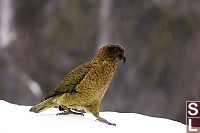
Tags: New Zealand(79), bird(22), volcanism(15), beach(12), cave(11), Do Not Tag(7)
People: David(5), Helen(5), Mark(5), John(2), Michael(2), Jin(1)
From: John Harvey Photo > Trips out of the Country > New Zealand
Last Modified Saturday, January 21st, 2023 at 23:44:24 Edit
Copyright and Contact Information.

 Nice place to go for a wedding
Nice place to go for a wedding

 Nice place to go for a wedding
Nice place to go for a wedding




























